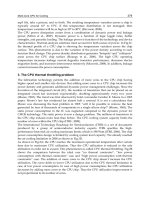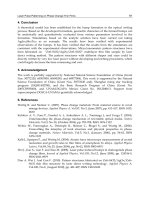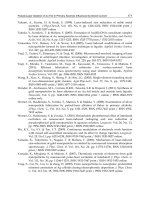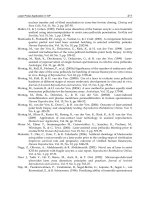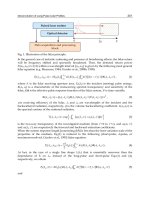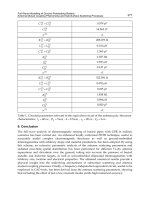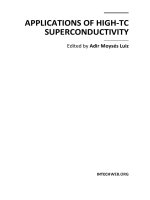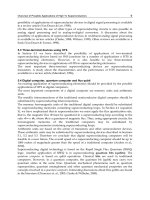Applications of High Tc Superconductivity Part 14 pptx
Bạn đang xem bản rút gọn của tài liệu. Xem và tải ngay bản đầy đủ của tài liệu tại đây (1.11 MB, 12 trang )
Superhard Superconductive Composite Materials
Obtained by High-Pressure-High-Temperature Sintering
249
The critical field value B
c
c
for magnetic field parallel to c axis is about 3–4 T down to T = 0
K (Lyard et al., 2002). The value of in plane critical magnetic field
B
c
ab
in the ab plane is
significantly higher and reaches 15–20 Т at T=0 K. The anisotropy coefficient is equal
B
c
ab
/
B
c
c
= 4–5. In the superconducting composite MgB
2
:С
60
-80%:20% we measured
superconducting transition at different magnetic fields. (Fig. 10a). Using these data the
temperature dependence of the critical magnetic field
B
c
was plotted in Fig. 10b. The
temperature dependence of
B
c
is close to the same dependence in the initial MgB
2
(Lyard et
al., 2002; Buzea & Yamashita, 2001). Thus composite with 20 wt. % of C
60
has the same
superconducting parameters as host MgB
2
.
Fig. 10. Temperature dependence resistance of R for MgB
2
:С
60
- 80:20 wt. % at different
magnetic field (a), and temperature dependence of critical magnetic field
B
c
(b) that is
similar to that of the initial MgB
2
.
Applications of High-Tc Superconductivity
250
4.3 Superconductivity of heterofullerides
Recently a method has been developed for synthesizing superconducting heterofullerides of
the Fe and Cu groups with the composition K
2
MC
60
(Bulychev et al., 2004). For example, Fig.
11a shows the temperature dependence of the magnetic susceptibility
χ
for fullerides with
M=Fe, Ni, Cu. Also shown in Fig. 11a is the
χ
(T) curve for the well-known superconductor
K
3
C
60
for comparison. Superconducting heterofullerides of composition K
2
MC
60
have lower
superconducting transition temperatures
T
c
than K
3
C
60
, and the crystal lattice constant a of
(a)
(b)
Fig. 11. Temperature dependence of the magnetic susceptibility
x of fullerides of
composition K
2
MC
60
(M = Fe, Ni, Cu) and K
3
C
60
for comparison (upper) and compounds
RbCsTlC
60
, KCsTlC
60
, Rb
2
TlC
60
(down).
Superhard Superconductive Composite Materials
Obtained by High-Pressure-High-Temperature Sintering
251
the heterofullerides studied is smaller than that of K
3
C
60
, apparently because substitution of
the potassium ion by an ion of smaller diameter decreases the lattice constant. Thus there is
a correlation between the superconducting transition temperature and the crystal lattice
constant: a decrease of
a leads to a decrease of T
c
.
Fullerides RbCsTlC
60
and Rb
2
TlC
60
have superconducting transition temperature T
c
= 26.4
K, and 27.2 K respectively. For KCsTlC
60
, the value of T
c
= 21.7 K is the highest for
fullerides with potassium atoms. Temperature dependences of the magnetic susceptibility of
these compounds are plotted in Figure 11b. The fulleride KCsTlC
60
possesses the highest T
c
= 21.7 K among all synthesized in the present study of heterofullerides with potassium. This
confirms the suggestion that the increase of the
T
c
value is due to the increase of the lattice
constant caused by substitution of K and Rb by Cs. KCsTlC
60
has maximal value of a (a =
1.442 nm compared to K
3
C
60
a = 1.431 nm) among all superconducting heterofullerides with
potassium. The same is for RbCsTlC
60
(a = 1.467 nm, Rb
2
BeC
60
a = 1.445 nm). Such
appreciable increase of the parameter
a of face-centred cubic lattice is quite naturally and
also is one more proof of intercalation of atoms of bigger sizes in fulleride structure. There
were no superconducting transitions in heterofullerides with more than one Cs atom per
fullerene C
60
. It is of substantial interest to investigate sintering of such compounds with
superhard materials like diamond and сBN to learn if superhard compounds protect
superconducting metal-fullerene compound against oxydation and provide high mechanical
properties of the composite.
5. Ti
34
Nb
66
- and Nb
3
Sn-diamond micropowder-systems
5.1 Ti
34
Nb
66
-diamond system
The NbTi alloy is a superconductor which has one of the best strength and high critical
magnetic field. A set of new composite materials were synthesized from Ti
34
Nb
66
and Nb
3
Sn
superconductors mixed with microcrystalline diamond and nanodiamond powders in
various bulk ratios. The particle size of superconductors was reduced to 5–10 µm by
powdering.
The initial Ti
34
Nb
66
alloy (Fig. 12) has a body-centered cubic crystal structure with I m
͞
3 m
space group and the unit cell parameter
а = 0.328 nm. The superconducting temperature T
C
= 9.85 К is known for this alloy.
The crystal structure of Nb
34
Ti
66
is a homogeneous solid solution with statistical distribution
of elements in a unit cell. Figure 13 shows diffractograms of samples obtained after sintering
of the mixture of diamond powder and superconductor under pressure of 7.7 GPa at
temperatures 1373 K and 1623 K. The lower diffractogram No. 4 (Fig. 13a) was obtained
from the initial alloy, the next one (No. 3) of the sample obtained after sintering at 1373 K.
No reflections of TiC or NbC appeared at this synthesis temperature.
The next two samples were sintered at 1623 K. The diffractogram No. 2 corresponds to the
sample Nb
34
Ti
66
(50%) mixed with 45% diamond micropowder covered by Nb and 5% of
nanodiamond is added in this composition. The diffractogram No. 1 corresponds to the
sample Nb
34
Ti
66
(50%) mixed with 50% diamond micropowder. We will discuss in detail the
difference of diffraction patterns of these samples and how it may affect on the
superconductive transition temperature.
At the dffractograms of samples No. 1 and 2 the diffraction peaks from Nb
34
Ti
66
alloy are
easy visible because they have maximal amplitude. They are slightly shifted one to another
and the shift is larger at wide angles (2
θ ∼ 90 ÷ 100
0
). A cubic unit cell parameter of Тi
34
Nb
66
Applications of High-Tc Superconductivity
252
Fig. 12. The crystal structure of Nb
34
Ti
66
alloy. Nb and Ti atoms have no determined
positions.
alloy calculated with the wide angles (see fig. 13)
а=0.329 nm of sample No. 1 is slightly less
than
а = 0.330 nm of sample No. 2. The intensities of the main peaks are different in these
two samples. The intensities of TiC and NbC peaks are different in these samples as well. In
sample No. 1 the intensity of TiC-reflections is higher than NbC-reflections while in sample
No 2 the intensity of NbC-reflections is higher than TiC-reflections. As for example, at 2
θ =
70÷75
0
and 85÷90
0
regions (Fig. 13b) NbC-reflections of diffractogram No. 1 disappear. The
additional Nb covering diamond crystals in sample No. 2 leads to higher quantity of NbC
in this sample. Apparently, 5% of nanodiamond in sample No. 2 increases a separation of
Nb. Taking into account that the atomic radius of Ti (0.146 nm) is higher than the atomic
radius of Nb (0.145 nm) and that the intensities of NbC – reflections increased, we suppose
that the concentration of Nb in sample No. 1 is higher than in sample No. 2. That is why the
cubic parameter is smaller. This leads to higher
Т
C
in sample No 1 than in sample No. 2 (Fig.
14).
The appearance of NbC and TiC evidences partial decomposition of Nb
34
Ti
66
alloy during
the synthesis. Carbides were synthesized under high pressure 7.7 GPa without melting of
metals though temperature of synthesis 1625 K is less than the necessary for direct synthesis
of carbides. Their melting temperatures exceed 2000 K. The large part of carbon (50%) in
samples promotes formation of carbides. However, the content of carbides is not sufficient
to rise the
T
C
value up to 12.6 K known for NbC carbide.
Table 3 shows the Vickers microhardness of Ti
34
Nb
66
–diamond composite samples No's 1
and 2. The value of microhardness has a wide range as well as in the other composites: the
lowest value of hardness has been measured for the Ti-Nb-alloy located in superconductive
channels (35 GPa in sample No. 1 and 42 GPa in sample No. 2) and the highest ones in
superhard matrix (93-98 GPa). We suppose that the higher hardness of channels (42 GPa) in
sample No. 2 has place due to nanodiamond fraction in this sample.
No. 1: 50% Ti
34
Nb
66
+ 50% diamond micropowder, T
C
=8.9 K;
No. 2: 50% Ti
34
Nb
66
+ 45% diamond micropowder covered by metallic Nb + 5%
nanodiamond,
T
C
=6 K.
Superhard Superconductive Composite Materials
Obtained by High-Pressure-High-Temperature Sintering
253
(a)
(b)
Fig. 13. (a) Diffractograms of (Ti
34
Nb
66
+ diamond micropowder) samples sintered at high
pressure 7.7 GPa and high temperature 1373 K and 1623 K. The composition of samples: 1)
50% Ti
34
Nb
66
+ 50% diamond micropowder, T=1623 K; 2) 50% Ti
34
Nb
66
+ 45% diamond
micropowder covered by Nb + 5% nanodiamonds, T=1623 K; 3) 50% Ti
34
Nb
66
+ 50%
diamond micropowder, T = 1373 K; 4) initial Ti
34
Nb
66
alloy.
(b) X-ray diffractograms of samples No's. 1 and 2.
.
D – diffractional reflections of diamond,
NbC and TiC – diffractional reflections from Nb and Ti carbides. TiNb and the wide angles
of 2
θ
0
are denoted for Ti
34
Nb
66
reflections.
Applications of High-Tc Superconductivity
254
Fig. 14. Temperature dependence of resistance in two superhard composites sintered at T =
1623 K and P =7.7 GPa.
Sample
No.
Composite
Component
ratio, wt.%
Vickers
microhardness,
GPa
T
c,
K
1
Ti
34
Nb
66
–diamond
micropowder
50:50 35-93 8.9
2
Ti
34
Nb
66
–(diamond
micropowder covered by Nb +
5% nanodiamond)
50:50 (45:5) 42-98 6
Table 3. The Vickers microhardness and the temperature of superconductive transition T
C
of
synthesized composite materials.
5.2 Nb
3
Sn-diamod-system
An intermetallic Nb
3
Sn compound crystallizes in cubic structure type A-15. Tin atoms are
located in body-centered cubic positions, pairs of Nb atoms located on the cubic faces
parallel to the coordinate axes (fig. 15). The unit cell contains 8 atoms: 2 Sn + 6Nb; the space
group
Pm3n, a
cub.
= 0.529 nm. Nb-atoms generate cross-cut chains (fig. 15a). The interatomic
distance for Nb-atoms in one chain is appreciably less than the distance in the different
chains. The chains of Nb-atoms respond for the generation of quasi one-dimensional
electronic spectrum of
d-state in this structure.
Nb
3
Sn was mixed with micropowdered synthetic diamond and sintered at P = 7.7 GPa,
T=1623 K. The diffraction pattern in Fig. 16 shows that under high temperature and pressure
Nb
3
Sn partially decomposes to atoms of Nb and Sn. Metallic Nb creates NbC, while Sn in
sample is in metallic state. It is worth to note that the temperature of synthesis 1623 K is
much less than the melting temperature of Nb
3
Sn (2400 K). It means that niobium carbide
was synthesized in solid state without melting of metal. The content of metallic Sn is very
Superhard Superconductive Composite Materials
Obtained by High-Pressure-High-Temperature Sintering
255
Fig. 15. The crystal structure of Nb
3
Sn. a –Positions of atoms in the unit cell, b – chains of Nb-
atoms. The coordinate axes are denoted in the
b-part where two unit cell are painted.
small. Positions of diffractions peaks of Nb
3
Sn correspond to the diffraction database (ICDD
database PDF-2, card № 19-0875). Thus the decomposition of Nb
3
Sn is insignificant in spite
of high parameters of sintering. The composite Nb
3
Sn with diamond powder is a
superconductor with
T
C
about 15.5 K as it is shown in fig. 17. This value of T
C
is close to the
T
C
of the initial Nb
3
Sn.
Fig. 16. X-ray diffraction pattern of (50%Nb
3
Sn + 50% micropowder diamond) sample
sintered at P = 7.7 GPa, T = 1625 K; D – reflections of diamond, NbC – reflections of niobium
carbide.
Applications of High-Tc Superconductivity
256
Fig. 17. Temperature dependence of resistance in different superhard composites: 1 –
50%Nb
3
Sn + 50% micropowder diamond (T
C
=15.6 K); 2 – 70%Nb
3
Sn + 30% micropowder
diamond (
Т
C
=15.5 K) and 3 – MgB
2
+cBN (T
C
=36.5 K) for comparison.
6. Conclusion
The superhard superconducting composites are the new large family of materials for
cryogenic electro-mechanical tools and devices. We employed high-pressure-high-
temperature technique for synthesis of various superconducting composites on the basis
of the hardest known materials: diamond, cubic boron nitride, C
60
-fullerites. The best
traditional superconductor alloys and relatively new, like MgB
2
have been used for
synthesis to provide a superconductivity of the target materials. The structure and
properties of the synthesized composites have been investigated. The highest values of
microhardness up to 98 GPa and the highest elastic moduli have been found in diamond-
based composites. Among them diomond-niobium composite is the hardest and it
possesses 12.5K superconductor transition temperature. The highest
T
C
= 37.5 K has
diamond-niobium-MgB
2
composite. The composites of superhard materials with
conventional superconductor alloys like Ti
34
Nb
66
and Nb
3
Sn also possess
superconductivity with the critical temperature 8.9 - 15.6 K. The optimal ratio of
superconductor to superhad compounds in composites varies in the range from 20:80 to
50:50 wt%. The pressure and temperature parameters of synthesis are rather high: P = 7.7 -
12.5 GPa ; T
s
= 1373 - 2173 K at the heating time τ = 60 – 90 s. However it may be supposed
that with the increase of τ the pressure and temperature of synthesis may be reduced
substantially. The X-ray diffraction analysis revealed formation of metal carbides on the
boundaries of diamond micro- and nanocrystals and nanocarbon phases originated from
C
60
fullerene. The carbide phases provide strong chemical bonding of superconductor
matrix with superhard carbon grains, thus the target composites possess very high
strength. The obtained new composite materials can be successfully used in cryogenic
Superhard Superconductive Composite Materials
Obtained by High-Pressure-High-Temperature Sintering
257
electro-mechanical systems and in cryogenic research devices. The unique high-strength
superconducting anvils for research pressure-induced apparatus were made and
employed for investigations of the pressure effect up to 22 GPa on the superconductor
transition temperatures in the metallic high-pressure phase of GaP.
7. References
Blank, V.; Buga, S.; Dubitsky, G.; Serebryanaya, N.; Popov, M. & Sundqvist, B. (1998). High-
Pressure Polymerized Phases of C
60
. Carbon, V. 36, No 4, (April 1998), pp. 319-343,
ISSN 0008-6223
Blank, V.; Buga, S.; Dubitsky, G.; Serebryanaya, N.; Prokhorov, V.; Mavrin, B.; Denisov, V.;
Chernozatonskii, L.; Berezina, S. & Levin, V. (2006). Synthesis of Superhard and
Ultrahard Materials by 3D-polymerization of C
60
, C
70
Fullerenes under High
Pressure (15 GPa) and Temperatures up to 1820 K.
Zeitschrift fur Naturforschung
section B-A Journal of Chemical Sciences,
Vol. 61 b, No 12, (December 2006), pp. 1547-
1554, ISSN 0932-0776
Blank, V., Buga, S., Dubitsky, G., Gogolinsky, K., Prokhorov, V., Serebryanaya, N.; Popov,
V. (2007). High-Pressure Synthesis of Carbon Nanostructured Superhard
Materials., In:
Molecular Building Blocks for Nanotechnology , Mansoori, A., George,
T., Assoufid, L., Zhang, G., pp. 393-418. Springer Science+Business Media LLC,
ISBN-10: 0-387-39937-2, New York, U.S.A.
Buga, S.; Blank, V.; Dubitsky, G.; Edman, L.; Zhu, X M.; Nyeanchi, E. & Sundqvist, B. (2000).
Semimetallic and Semiconductor Properties of Some Superhard and Ultrahard
Fullerites in the Range 300–2 K.
Journal of Physics and Chemistry of Solids, Vol. 61, No
7, (July 2000), pp. 1009-1015, ISSN 0022-3697
Buga, S.; Blank, V.; Serebryanaya, N.; Dzwilewski, A.; Makarova, T. & Sundqvist, B. (2005).
Electrical Properties of 3D-Polymeric Crystalline and Disordered C
60
and C
70
fullerites.
Diamond and Related Materials, Vol. 14, Issue: 3-7, Special Issue: Sp. Iss. SI,
(Mart-July 2005), pp. 896-901, ISSN 0925-9635
Bulychev, B., Lunin, R., Krechetov, A., Kulbachinskii, V., Kytin, V., Poholok, K., Lips, K.;
Rappich, J. (2004)
J. Phys. Chem. Solids Vol. 65, (2004) pp. 337-343
Buzea, C. & Yamashita, T. (2001). Review of the Superconducting Properties of MgB
2
.
Superconductor Science &Technology, Vol. 14, No 11, (November 2001), pp. R115-
R146, ISSN: 0953-2048
Dou, S.; Yeoh, W.; Horvat, J. & Ionescu, M. (2003). Effect of Carbon Nanotube Doping on
Critical Current Density of MgB
2
Superconductor. Applied Physics Letters, Vol. 83,
No 24, (15 December 2003), pp.4996-4998, ISSN 0003-6951
Dubitsky, G; Blank, V.; Buga, S.; Semenova, E.; Kul’bachinskii, V.; Krechetov, A. & Kytin, V.
(2005). Superhard Superconducting Materials Based on Diamond and Cubic Boron
Nitride.
JETP Letters, Vol 81, No 6, (June 2005), pp. 323-326, ISSN 0021-3640
Dubitsky, G.; Blank, V.; Buga, S.; Semenova, E., Serebryanaya, N.; Aksenenkov, V.;
Prokhorov, V.; Kul’bachinskii, V.; Krechetov, A. & Kytin, V. (2006). Superhard
Superconductor Composites Obtained by Sintering of Diamond, c-BN and C
60
Powders with Superconductors.
Zeitschrift fur Naturforschung section B-A Journal of
Applications of High-Tc Superconductivity
258
Chemical Sciences, Vol. 61 b, No 12, (December 2006), pp. 1541-1546, ISSN 0932-
0776
Dubrovinskaya, N., Eska, G., Sheshin, G., Braun, H.; (2006) Superconductivity in
Polycrystalline Boron-doped Diamond Synthesized at 20 GPa and 2700K.
Journal of
Applied Physics
, Vol. 99 (February 2006) pp. 0333903-1 -7, ISSN 0021-8979
Ekimov, E.; Sidorov, V.; Bauer, E.; Mel’nik N.; Curro, N.; Thompson, J. & Stishov S. (2004).
Superconductivity in Diamond.
Nature, Vol. 428, No 6982, (April 2004), pp. 542-545,
ISSN 0028-0836
Gurevich, A.; Minc, R. & Rakhmanov, A. (1987).
Fizika kompositnyh sverhprovodnikov,
(Russian.), Nauka, Moscow, USSR
Holczer, K. & Whetten, R. (1993). Superconducting and Normal State Properties of the A
3
C
60
Compounds, In:
The Fullerenes, Kroto, H.; Fischer, J. & Cox, D., pp. 123-138.
Pergamon Press, ISBN 0-08-042152-0, Oxford, UK
Jung, C.; Park, M S.; Kang, W.; Kim, M S.; Kim, K.; Lee, S. & Lee, S I. (2001). Effect of
Sintering Temperature under High Pressure on the Superconductivity of MgB
2
.
Applied Physics Letters, Vol. 78, No 26, (25 June 2001), pp. 4157-4159, ISSN 0003-
6951
Karimov, Yu. & Utkina. (1990). Superconductivity of Nonstoichiometric Niobium Carbide.
Pis’ma v Zhurnal Eksperimental I Teoreticheskoi Fiziki, Vol. 51, No. 9, (May 1990), 468-
470. (
Journal Experimental and Theoretical Physics Letters, Vol. 51, No. 9, (May 1990),
pp. 528-531, ISSN 0021-3640
Krasnosvobodtsev, S.; Shabanova, N.; Ekimov, E.; Nozdrin, V. & Pechen', E. (1995). Critical
Magnetic Field of NbC: New Data on Clean Superconductor Films.
Zhurnal
Eksperimental i Teoreticheskoi Fiziki, Vol. 108, No. 3(9), (September 1995), pp.970-976.
(
Journal Experimental and Theoretical Physics, Vol. 81, No. 3, (September 1995), pp.
534-537, ISSN 1063-7761
Kulbachinskii, V. (2004) . Electronic properties and superconductivity of low-dimensional
carbon structures
Low Temperature Physics Vol. 30 , No. 11, (November 2004), pp.
826-833.
Kulbachinskii, V, Bulychev, B., Kytin, V., Krechetov, A., Konstantinova, E.;. Lunin, R.
(2008). Superconductivity, electron paramagnetic resonance, and Raman
scattering studies of heterofullerides with Cs and Mg.
Advances in Condensed
Matter Physics
Vol. 2008 (2008), Article ID 941372, 6 pages
doi:10.1155/2008/941372
Kulbachinskii, V.; Buga, S.; Blank, V.; Dubitsky, G. & Serebryanaya N. (2010).
Superconducting Superhard Composites Based on C
60
, Diamond or Boron Nitride
and MgB
2
. Journal of Nanostructured Polymers and Nanocomposites, Vol. 6, No. 4,
(2010), pp. 119-122, ISSN 1790-4439
Lyard, L.; Samuely, P.; Szabo, P.; Klein, T.; Marcenat, C.; Paulius, L.; Kim, K.; Jung, C.; Lee,
H.; Kang, B.; Choi, S.; Lee, S.; Marcus, J.; Blanchard, S.; Jansen, A.; Welp, U.;
Karapetrov, G. & Kwok, W. (2002). Anisotropy of the Upper Critical Field and
Critical Current in Single Crystal MgB
2
. Physical Review B, Vol. 66, No. 18,
(November 2002), pp. 180502(4), ISSN 0163-1829
Superhard Superconductive Composite Materials
Obtained by High-Pressure-High-Temperature Sintering
259
Nagamatsu, J.; Nakagawa, N.; Muranaka, T.; Zenitani, Y. & Akimitsu, J. (2001). Nature, Vol.
410, No. 6824, (March 2001), pp. 63-64, ISSN 0028-0836
Narozhnyi, V.; Stepanov, G.; Dubitsky, G.; Semenova, E. & Yakovlev, E. (1988). Kamera
Vysokogo Davleniya iz sverhprovodyaschego Materiala (in Russian).
Fizika I
Tehnika Vysokih Davlenii,
No. 27, (1988), pp. 88-91, ISSN 0203-4654
Pachla, W.; Kovac, P.; Diduszko, R.; Mazur, A.; Huek, I.; Morawski, A. & Presz, A. (2003).
Supercondor Science and Technology, Vol. 16, No. 7, (January 2003), pp. 7-13, ISSN
0953-2048
Pickett, W.; Klein, B. & Zeller, R. (1986). Electronic structure of the carbon vacancy in
NbC.
Physical Review B, Vol. 34, No. 4 (August 1986), pp. 2517-2521, ISSN 1098-
0121
Prikhna, T.; Gawalek, W.; Surzhenko, A.; Moshchil, V.; Sergienko, N.; Savchuk, Y.;
Melnikov, V.; Nagorny, P.; Habisreuther, T.; Dub, S.; Wendt, M.; Litzkendorf, D.;
Dellith, J.; Schmidt, C.; Krabbes, G. & Vlasenko, A.(2004) High-pressure Synthesis
of MgB
2
with and without Tantalum Additions. Physica C-Superconductivity and its
Applications,
Vol. 372, (2004), pp. 1543-1545, ISSN: 0921-4534
Prokhorov, V.; Blank, V.; Buga, S. & Levin, V. (1999) Scanning Acoustic Microscopy Study of
Superhard C
60
Based Polimerized Fullerites. Synthetic Metals, Vol. 103, No. 1-3, pp.
2439-2442, ISSN 0379-6779
Shabanova, N.; Krasnosvobodtsev, S.; Nozdrin, V. & Golovashkin, A. (1996). Upper Critical
Magnetic Field and Electron Characteristics of NbC, Nb
3
Sn, RBa
2
Cu
3
O
7
Superconducting Compounds where (R=Y, Ho).
Fizika Tverdogo Tela, Vol. 38, No. 7,
(July 1996), pp. 1969-1985. (
Physics of the Solid State, Vol.38, No. 7, pp.1085-, ISSN
1063-7834)
Shul’zhenko, A.; Ginsburg, B.; Hovah, N. & Pruss, A. (1987). New Superhard Materials
abroad (reiew) (in Russian).
Sverhtverdye Materialy, No. 1, pp. 23-28, ISSN 0203-
3119.
Sidorov, V.; Ekimov, E.; Stishov, S.; Bauer, E. & Thompson, J. ( 2005). Superconducting
and Normal-State Properties of Heavily Hole-Doped Diamond.
Physical Review
B,
Vol. 71, No. 6, (June 2005), pp. 060502(4), Rapid Communications, ISSN 1098-
0121
Tampieri, A.; Celotti, G.; Sprio, S.; Caciu
ffo, R. & Rinaldi, D. (2004). Study of the Sintering
Behavior of MgB
2
Superconductor During Hot-Pressing. Physica C, Vol. 400, No. 3,
(2004), pp. 97–104, ISSN 0921-4534
Toulemonde, P.; Musolino, N. & Flukiger, R. (2003). High-pressure Synthesis of Pure and
Doped Superconducting MgB
2
compounds. Superconductor Science & Technology,
Vol. 16, No. 2, (February 2003), pp. 231-236, ISSN 0953-2048
Toth, L. (1971) Transition Metal Carbides and Nitrides. Academic, New York, 1971. (Mir,
Moscow, 1974)
Willens, R.; Boehler, E. & Matthias, B. (1967). Superconductivity of the Transition-Metal
Carbides.
Physical Review, Vol. 159, No. 2, (July 1967), pp. 327-330.
Zenitani, Y. & Akimitsu, J. (2003). Discovery of the New Superconductor MgB
2
and its
Recent Development.
Association Asia Pacific Physical Societies Bulletin, Vol. 13, No. 1,
(February 2003), pp. 26-33, ISSN 0218-2203.
Applications of High-Tc Superconductivity
260
Zhao, Y.; Cheng, C.; Rui, X.; Zhang, H.; Munroe, P.; Zeng, H.; Koshizuka, N. & Murakami,
M. (2003). Improved Irreversibility Behavior and Critical Current Density in MgB
2
-
Diamond Nanocomposites.
Applied Physics Letters, Vol. 83, No. 14, (October 2003),
pp. 2916-2918, ISSN 0003-6951.

